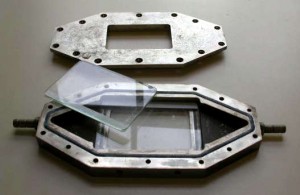Bacterial Biofilm Development on Hydroxyapatite-Coated Glass

Flow cell apparatus dismantled.
Glass plates are frequently used as the substratum in flow cell experiments to allow continuous non-destructive observations of biofilm development via microscopy. The aim of this study was to evaluate hydroxyapatite-coated glass as a substratum for flow cell experiments, in comparison to plain glass, for modelling primary colonization of the tooth surface by Streptococcus sanguis. Glass plates were magnetron sputter coated with hydroxyapatite, producing a thin transparent layer. Biofilm development in the flow cell was recorded using image capture from a microscope, and images were analyzed to determine percentage coverage of the substratum over 24 h. Removal of biofilm by increasing the flow rate was also assessed. No statistically significant differences were detected between S. sanguis biofilms grown on the two different substratum materials. Hence, this work supports the proposal that the conditioning film reduces the influence of substratum surface properties.